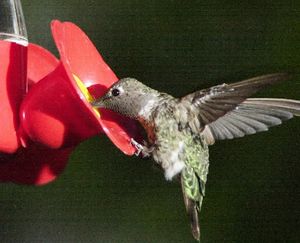Feeder watch: Hummingbirds seem to benefit from higher dose of sugar
WILDLIFE WATCHING -- Can sweetening the feeding solution reduce bickering among hummingbirds at a feeder?
Spokane County birder Greg Falco thinks so.
The south Spokane County birding enthusiast experimented with solutions and came up with some results that are being debated by birders this week.
"I read someplace not to long ago that anything more than 4-1 (water-sugar solution) can cause hummers to have heart attacks and is NOT recommended!" said Terry Gray, and avid birder from Moscow.
While the discussion goes on, here are Falco's observations (with the possibility that other factors could be influencing the results):
I've been feeding about 50 hummers lately.
I did some research and found if I doubled the sugar in the water, they would feed half as often.
I tried it and found it to be so, after the first day.
There is less fighting for food and it seems to be a more efficient way of feeding them.
DETAILS
I was feeding 1 part sugar to 4 parts water and going through 8 cups of feed a day. Five feeders.
Hummers were probably feeding every 3 minutes.
I estimate I have 20 black-chinned (local nesters), 20 migrant rufous, and 10 migrant calliope.
I changed to feed 1 part sugar to 2 parts water and I'm now going thru 4 cups of feed a day.
(The first day on the extra sugar they went crazy with all trying to feed at once all day. Then they adjusted)
They are probably now feeding 10 to 12 times an hour.
Calvor Palmateer, who resides part of the year in Victoria, British Columbia, responded:
Regarding hummingbird sugar ratios -- on Vancouver Island people began feeding between anywhere from 1/3 cup sugar to 1 cup sugar to 1 cup water twenty years ago. Since most Anna's on the coast do have to winter -10 Celsius at least for some portion of a normal year, it made sense to increase the concentrations during those cold periods. The practice spread to year around. It is a major myth that higher concentrations cause problems. Instead the Anna's population has grown with females raising three and four sets of young.
One researcher in Victoria showed the hummers prefer higher concentrations and move to those feeders. With banders working at some of these higher concentration feeders it shows normal life lengths. Not increased mortality.
Banding also shows hummingbirds are consistent in their migration dates. Leaving hummingbird feeders up dies not change that but can save a wandering Anna's.
Yet another birder, who pointed out that she was watching hummingbirds at her feeder in a campsite as she responded by mobile phone, offered this:
I read somewhere a couple summers ago that we should take down our feeders in mid-July, July 15th being recommended, so as to not contribute to the hummers lingering around & getting a possibly too-late start with migration. Since we are on the eve of July 15th this seemed like a good time to toss this out there for (educated) opinion.
Mike Denny of Walla Walla says:
I agree the sugar concentration doesn't hurt the hummers. The trouble I have found in our hot valley is that the higher the concentration of sugar the quicker the mixture sours. I have to change the feeders every three days.
Here's a report based on some science:
More info: hummingbirds.net

